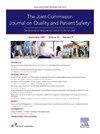Mortality and Return Visit Frequency Among Emergency Department Patients Who Leave Without Being Seen at a Regional Health Care System
IF 2.4
Q2 HEALTH CARE SCIENCES & SERVICES
Joint Commission journal on quality and patient safety
Pub Date : 2025-07-01
DOI:10.1016/j.jcjq.2025.02.008
引用次数: 0
Abstract
Background
The rate of emergency department (ED) patients who leave without being seen (LWBS) is a commonly reported quality metric that increased across the United States in concert with COVID-19. However, it is unclear what proportion of patients leave despite an acute medical need. The authors sought to estimate the rates at which patients who leave return, including hospitalization, relative to patients who are evaluated and discharged.
Methods
This was a retrospective cohort study examining adult patients presenting between January 1, 2019, and January 1, 2023, across an integrated system including 10 EDs. Demographic variables were compared using independent chi-square tests. Clinical outcomes, including rates of return visits at 72 hours and 30 days (including inpatient admission or ICU admission), and 30-day mortality were compared using multivariate logistic regression.
Results
A total of 1,474,395 visits were included, of which 17,523 (1.2%) were LWBS. Patients in the LWBS group were younger (48.1 years [95% confidence interval (CI) 48.1–48.2] vs. 44.8 years [95% CI 44.6–45.1], p < 0.001), more likely to be of Hispanic ethnicity (177,895 [17.7%] vs. 3,884 [22.2%], p < 0.001), and more likely to require a translator (131,510 [13.1%] vs. 3,184 [18.2%], p < 0.001). Independent of other clinical and demographic variables, LWBS was associated with more frequent returns within 72 hours (adjusted odds ratio [AOR] 2.56, 95% CI 2.50–2.62, p < 0.001), 30-day ICU admission (AOR 1.35, 95% CI 1.27–1.66, p < 0.001), and mortality within 30 days (AOR 2.59, 95% CI 1.90–3.53, p <0.001).
Conclusion
Patients who left without being seen were more likely to return, to require admission, and to die within 30 days than those discharged. High LWBS rates, most pronounced among disadvantaged groups, should be considered as a source of harm to patients.
一个地区医疗保健系统中未就诊就离开的急诊科患者的死亡率和复诊频率。
背景:急诊科(ED)患者未就诊即离开的比例(LWBS)是一项常见的质量指标,随着 COVID-19 的实施,该指标在全美范围内有所上升。然而,目前还不清楚有多大比例的患者在有紧急医疗需求的情况下离开了急诊室。作者试图估算出与接受评估并出院的患者相比,离开医院的患者返回医院(包括住院)的比例:这是一项回顾性队列研究,研究对象是 2019 年 1 月 1 日至 2023 年 1 月 1 日期间在一个包括 10 家急诊室在内的综合系统中就诊的成年患者。采用独立卡方检验对人口统计学变量进行比较。使用多变量逻辑回归比较了临床结果,包括 72 小时和 30 天内的复诊率(包括住院或入住重症监护室)以及 30 天内的死亡率:共纳入了 1,474,395 次就诊,其中 17,523 次(1.2%)为 LWBS。LWBS 组患者更年轻(48.1 岁 [95% 置信区间 (CI) 48.1-48.2] vs. 44.8 岁 [95% CI 44.6-45.1],P < 0.001),更可能是西班牙裔(177 895 [17.7%] vs. 3 884 [22.2%],P < 0.001),更可能需要翻译(131 510 [13.1%] vs. 3 184 [18.2%],P < 0.001)。与其他临床和人口统计学变量无关,LWBS 与更频繁的 72 小时内返院(调整后赔率 [AOR] 2.56,95% CI 2.50-2.62,p < 0.001)、30 天内入住 ICU(AOR 1.35,95% CI 1.27-1.66,p < 0.001)和 30 天内死亡率(AOR 2.59,95% CI 1.90-3.53,p 结论)相关:与出院患者相比,未就诊即离院的患者更有可能复发、需要入院治疗并在 30 天内死亡。弱势人群的未就诊率较高,应将其视为对患者造成伤害的原因之一。
本文章由计算机程序翻译,如有差异,请以英文原文为准。
求助全文
约1分钟内获得全文
求助全文
来源期刊

Joint Commission journal on quality and patient safety
HEALTH CARE SCIENCES & SERVICES-
CiteScore
3.80
自引率
4.30%
发文量
116
审稿时长
49 days
 求助内容:
求助内容: 应助结果提醒方式:
应助结果提醒方式:


